Suzuki GSX-R 1000 Service Manual: Clutch lifter pin inspection and adjustment
Refer to “clutch removal” and “clutch installation” .
| Note when inspection and adjusting the clutch lifter pin, it is not necessary to install the clutch onto the countershaft. |
Inspect and adjust the clutch lifter pin in the following procedures:
- assemble the following parts into the primary driven gear assembly.
- Clutch sleeve hub
- spring washer seat, spring washer
- clutch drive plates, clutch driven plates
- pressure plate
- clutch springs, clutch springs set bolts
Tightening torque clutch spring set bolt (a): 10 n·m (1.0 Kgf-m, 7.0 Lbf-ft)
| Note tighten the clutch spring set bolt little by little and diagonally. |
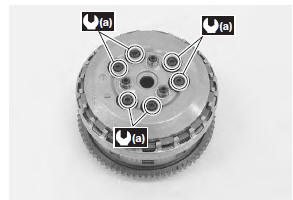
- Remove the clutch assembly from the primary driven gear assembly.
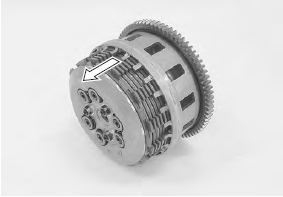
- Inspect the height “a” of clutch lifter pin at three positions using the thickness gauge. If the measurement is out of the specification, adjust the height “a” as shown in the figure.
Special tool
 : 09900–20803 (thickness gauge)
: 09900–20803 (thickness gauge)
Clutch lifter pin height “a” standard: 0.2 – 0.4 Mm (0.008 – 0.016 In)

- Loosen the lock-nuts (1) and turn out the clutch lifter pin (2).
| Note each clutch lifter pin height should be as closely as possible. |
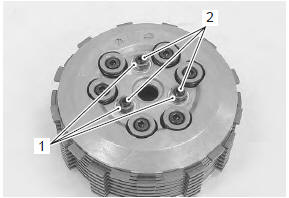
- Set the thickness gauge to 0.3 Mm (0.012 In).
Special tool
 (a): 09900–20803 (thickness gauge)
(a): 09900–20803 (thickness gauge)
- Place a proper flat plate on the thickness gauges and hold them by hand.
- Slowly turn in the clutch lifter pin (2) until resistance is felt.
- Tighten the lock-nut (1).
Tightening torque clutch lifter pin lock-nut (b): 23 n·m (2.3 Kgf-m, 16.5 Lbf-ft)
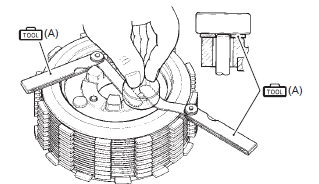
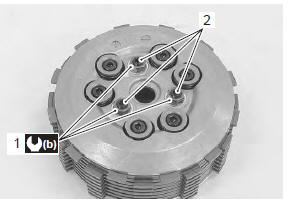
 Clutch parts inspection
Clutch parts inspection
Refer to “clutch removal” and “clutch installation” .
Clutch drive and driven plate
Note
wipe off the engine oil from the drive and
driven plates with a clean rag.
Measure t ...
 Specifications
Specifications
Service data
Clutch
unit: mm (in)
Tightening torque specifications
Note
the specified tightening torque is described in the following.
“Clutch control system components”&nbs ...
Other materials:
Battery current leakage inspection
Inspect the battery current leakage in the following
procedures:
turn the ignition switch off.
Remove the front seat. Refer to “exterior parts
removal and installation” in section 9d (page 9d-
6).
Disconnect the battery (–) lead wire.
Measure the current betwee ...
Rear brake components
Rear brake caliper
Piston seal
Dust seal
Piston
Rear caliper bracket
Rear brake pad set
Rear brake disc
Brake pad spring
6
N·m (0.6 Kgf-m, 4.5 Lbf-ft)
27 N·m
(2.7 Kgf-m, 19.5 Lbf-ft)
12 N·m
(1.2 Kgf-m, 8.5 Lbf-ft)
17 N·m ...
Front wheel assembly removal and installation
Removal
Remove the brake calipers, left and right.
Caution
do not operate the brake lever with the
caliper removed.
Loosen two axle pinch bolts (1) on the right front fork
leg.
Remove the front axle bolt (2).
Raise the front wheel off the ground a ...
